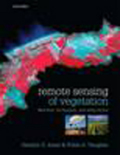
Remote sensing of vegetation: principles, techniques, and applications
Jones, Hamlyn G.
Remote sensing is becoming an increasingly important tool for agriculturalists, ecologists, and land managers for the study of Earth's agricultural and natural vegetation, and can be applied to further our understanding of key environmental issues, including climate change and ecosystem management. This timelyintroduction offers an accessible yet rigorous treatment of the basics of remote sensing at all scales, illustrating its practical application to the studyof vegetation. Despite a quantitative approach, the advanced mathematics and complex models common in modern remote sensing literature is demystified through clear explanations that emphasise the key underlying principles, and the core physical aspects are explained in the biological context of vegetation and its adaptation to its specific environment. Various techniques and instrumentsare addressed, making this a valuable source of reference, and the advantagesand disadvantages of these are further illustrated through worked examples and case studies. * Rigorous physical and mathematical principles presented in away readily understood by those without a strong mathematical background * Boxes throughout summarize key information and concepts * The student is directed to carefully chosen further reading articles, allowing them to explore key topics in more detail Online Resource Centre The Online Resource Centre to accompany Remote Sensing of Vegetation features: For Students: * Links to useful websites For lecturers: * Figures from the book in electronic format, ready to download INDICE: PREFACE; LIST OF SYMBOLS AND ABBREVIATIONS; 1. Introduction; 2. Basics of radiation physics for remote sensing of vegetation; 3. Radiative properties of vegetation, soils and water; 4. Plant and canopy function; 5. Earth observation systems; 6. Preparation and manipulation of data; 7. Spectral sensing of vegetation properties; 8. Multiangular sensing of vegetation structure and modelling of radiation transfer properties; 9. Remote sensing of canopy mass and heat exchange; 10. Sampling, error and scaling; 11. Integrated applications; REFERENCES; USEFUL WEBSITES; APPENDICES; ANSWERS TO SAMPLE QUESTIONS; INDEX
- ISBN: 978-0-19-920779-4
- Editorial: Oxford University
- Encuadernacion: Rústica
- Páginas: 400
- Fecha Publicación: 30/06/2010
- Nº Volúmenes: 1
- Idioma: Inglés
